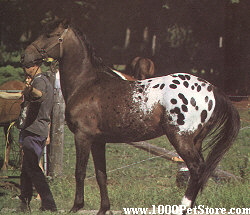The Palouse River runs through northern Idaho and parts of Oregon and Washington. The Nez Perce tribe of Indians, so named by Europeans because the ceremoniously pierced their noses, lived in that region of the American West, sheltered from marauders by high mountains. Wandering tribes sold or traded horses to the Nez Perce, who were particularly attracted to those animals with spots on their rumps. Spotted horses were also much admired by other cultures. Spanish and Portuguese Andalusians bearing such markings were prized, as court painters such as Velasquez noted. American Indians attributed special magical powers to multi-colored animals, and the Nez Perce selectively bred spotted horses to refine coloration patterns. In 1804 Lewis and Clark set out on their famous expedition commissioned by Thomas Jefferson to explore the American heartlands acquired from the French through the Louisiana Purchase. Lewis noted in his journal that the horses favored by the tribe were 'pied with large spots of white irregularly scattered and intermixed with some other dark color.
Other white men played a decisive role in the history of the Appaloosa. Missionaries preached against the Nez Perces preoccupation with horses, but although some tribesmen were swayed by their arguments and remained sedentary fishermen and farmers, others continued to breed and use horses, especially against encroachments of the white settlers. The Indians were outnumbered when hostilities broke out, and following a valiant fight and thousand mile retreat lead by Chief Joseph, the Nex Perce were defeated. Their horses either perished or were scattered throughout the West.
Not every spotted horse can qualify as a true Appaloosa. Coloration should normally consist of dark spots randomly sprinkled on a white patch over solid-colored hindquarters. However, horses without these 'blankets' but with small spots all over their bodies are know as 'Leopards' and can be registered as Appaloosas. Other important distingquishing characteristics of the breed are the unique circle of white round the iris which gives it the appearance of a human eye, mottle skin around the muzzle, striations running the length of all four hooves, and a short tail. With regard to conformation, Appaloosas have pointed ears, a deep chest over sloping shoulders, and solid hips. The have strong legs and well-defined withers. Their weight averages slightly more than 450kg (1,000lb.), and their height averages just over 15 hands (153cm).

APPALOOSA
www.appaloosa.com Appaloosa Horse Club
www.stallionstation.com/ss/directory/appaloosa.html
www.netrax.net/~aliasme/index.html
www.thesalebarn.com Everything Horses.